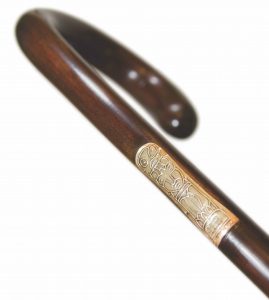 ITEM: Class cane
ITEM: Class cane
DATE: 1926
DESCRIPTION: Tapering hardwood walking cane 35 inches long, with a 5-inch curved handle.
ORIGIN: Unknown
The tradition of college canes seems to have been fairly common in the United States during the 19th century and the early part of the 20th. At Amherst College, for instance, freshmen had to wear a beanie, but as sophomores, they could wear a class top hat and carry a class cane. At Dartmouth College, the eagerness of first-year students to gain these status symbols led to a yearly competition called the Cane Rush, eventually banned for the violence it provoked. Today few remnants of that tradition survive. At Dartmouth, during Commencement, graduating seniors still carry canes topped with carvings related to their senior society—such as a griffin or a phoenix. And at Amherst, the tradition had a brief revival in 2003, when the College awarded specially designed class canes to all of its graduating seniors.
At Pomona there are only a few tantalizing references to the cane tradition. For instance, a description of campus activities in 1911 says: “If freshmen won both the Pole Rush and the subsequent freshman-sophomore football game, they got to carry around canes for a few weeks. If the sophomores won, they got to punish the freshmen by making them wear something embarrassing and smacking them with paddles if they refused.”
The cane pictured here is from the Class of 1926, as evidenced by the inlaid metal strip embossed with the totem pole design that was the symbol of that class, also to be found in the pages of that year’s Metate yearbook. Beyond that we know nothing. It was discovered in a closet of the Alumni Relations Office in Seaver House, its provenance and history unknown. If you have information to share about this cane or about the class cane tradition at Pomona, we invite you to contact us.
If you have an item from Pomona’s history that you would like to see preserved in the Pomona College Archives, please call 909-621-8138.
